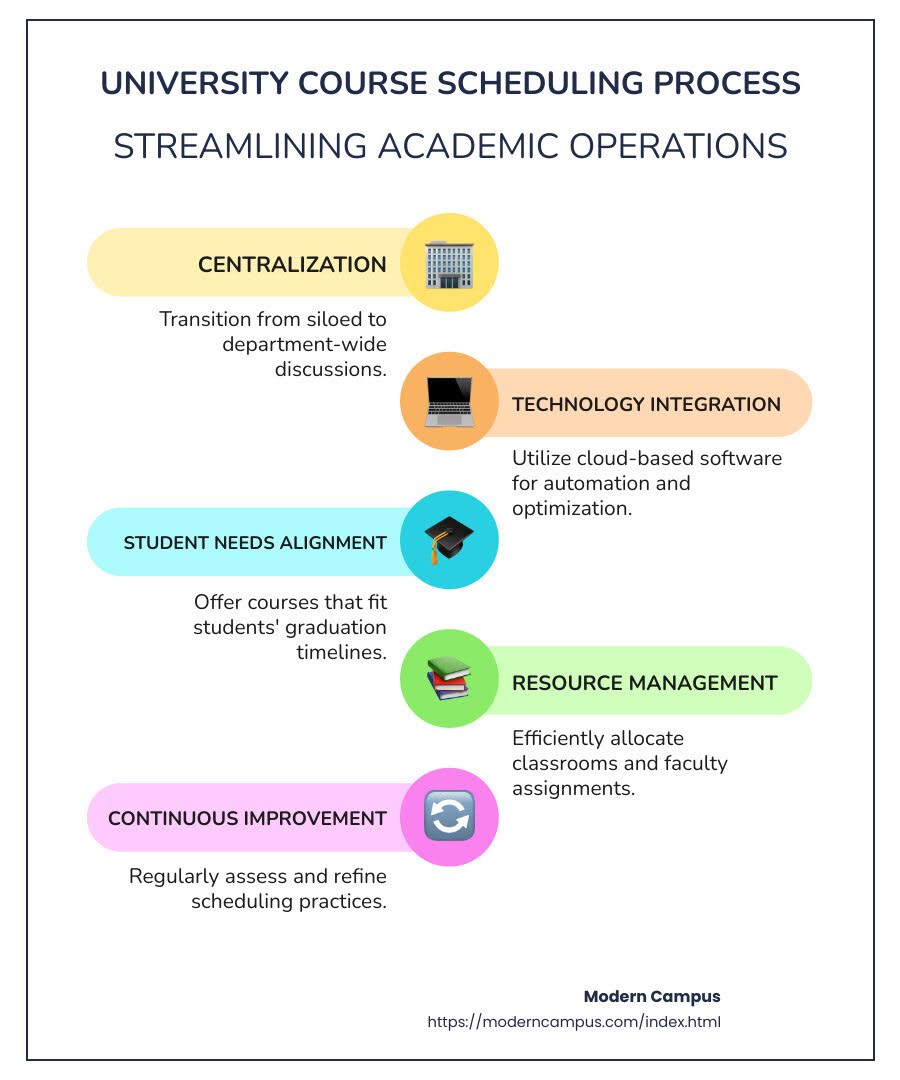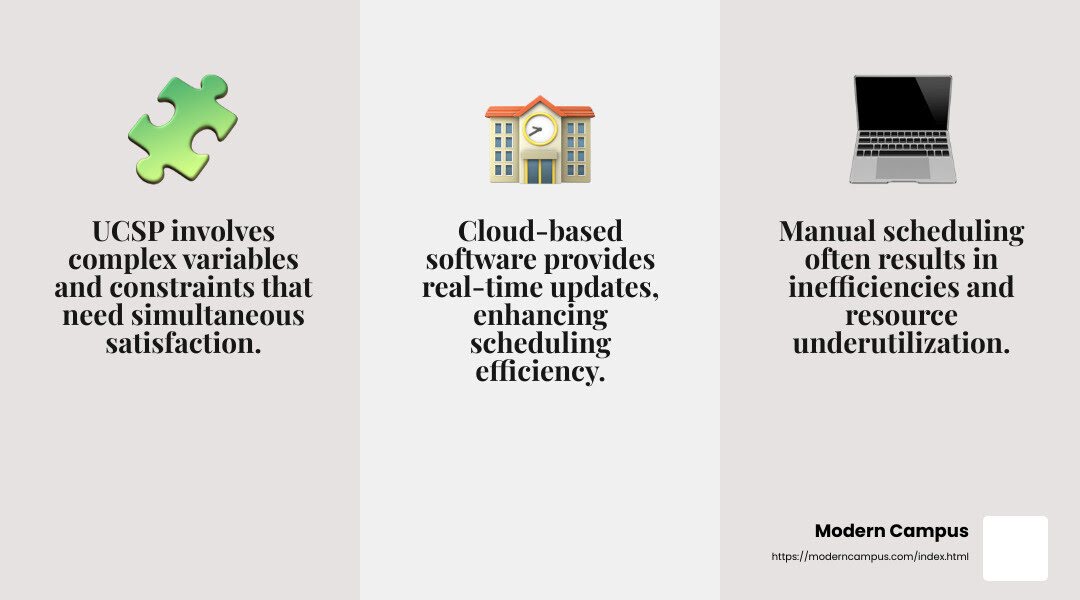Ways to Calm the Chaos of the University Course Scheduling Season
University course scheduling can be complex as it involves academic scheduling and technological systems to ensure students get the classes they need. It can feel chaotic, but this is where an efficient course scheduling system becomes indispensable.
Each university tackles this challenge differently, with some embracing centralized scheduling to streamline their operations. Traditional scheduling is often siloed but college administrators must shift to a college-wide discussion for efficiency and opportunity spotting.
While institutes like the University of Iowa have adopted time blocking, innovative solutions like cloud-based software further improve academic scheduling by automating complex tasks and optimizing classroom use. The goal is to keep students on track for graduation while making the job of schedulers more manageable.

Common Problems with University Course Scheduling
The University Course Scheduling Problem (UCSP) is a common yet intricate issue faced by higher ed institutions. Rather than assigning classes to time slots and rooms, it involves balancing student needs, faculty availability and resource constraints.
The 2004 research on UCSP highlights how the problem is not only logistical but also mathematical—involving multiple variables and constraints that must be satisfied simultaneously. Researchers suggest that solving the UCSP requires a systematic approach, often leveraging advanced algorithms or optimization models.
Traditionally, scheduling was done manually by faculty and department chairs. However, this method often leads to inefficiencies as departments end up working in silos without a holistic view of the university's needs. This can cause scheduling conflicts and inefficient use of resources.
Institutions are able to address these challenges by centralizing the scheduling process and using time blocking to maximize classroom usage while meeting student needs more effectively. In doing so, classrooms are used optimally and students can enroll in courses required to graduate on time.
Incorporating technology into scheduling processes can also mitigate the chaos. Modern solutions, such as cloud-based software, automate complex scheduling tasks and provide real-time updates. This ultimately makes it easier to adapt to changes and resolve conflicts quickly.

Understanding and addressing the UCSP allows universities to support student success and streamline their operations. By adopting strategic and technological solutions, institutions can transform scheduling from a chaotic task into a well-organized process that benefits everyone involved.
Strategies for Effective Course Scheduling
Institutions need to adopt smart strategies to tame the chaos of university course scheduling. These strategies revolve around three key areas: course scheduling tools, scheduling policies and room allocation.
Course Scheduling Tools
Course scheduling tools are revolutionizing the way universities manage the often chaotic process of building schedules that meet the diverse needs of students, faculty and administrators. Automated systems sync with student information systems (SIS) to update schedules in real time. Automation reduces manual data entry and cuts down on errors.
These tools streamline the scheduling process by integrating data-driven insights and automating complex tasks like room assignments, conflict detection and course demand analysis. By offering a centralized platform, they enable institutions to create more efficient, student-centric schedules while reducing administrative burden.
Advanced features like real-time collaboration, automated optimization and robust reporting ensure that every stakeholder benefits from a seamless experience—paving the way for improved enrollment outcomes and resource utilization. These solutions empower universities to focus on delivering exceptional educational experiences rather than navigating logistical headaches.
Scheduling Policies
Clear and effective scheduling policies provide a framework that guides the scheduling process, ensuring consistency and fairness across departments.
The University of Arizona serves as a great example, having implemented classroom usage guidelines to improve utilization. By adopting similar guidelines, universities can ensure that every classroom is used to its fullest potential.
Room Allocation
With limited space, universities must be strategic about how they assign rooms to courses— matching the room's features with the course's needs. Universities can allocate rooms more effectively by analyzing course demand projections and faculty assignments. This proactive approach helps prevent bottlenecks and ensures that students can enroll in the classes they need.
Adopting these strategies can lead to significant improvements. For instance, Stark State saved $2 million in instructional costs by offering more courses at times students wanted, increasing their tuition yield by $1.3 million.
By focusing on these areas, universities can transform their scheduling process into a streamlined operation that meets both student and faculty needs. This not only supports student success but also improves the institution's overall efficiency.
Leveraging Technology for Scheduling Efficiency
Technology offers powerful solutions to streamline university course scheduling. By embracing scheduling software, real-time sync and automation, these organizations can significantly reduce the chaos and improve efficiency.
Scheduling Software
Modern scheduling software handles complex tasks by making millions of calculations to optimize schedules. For instance, platforms allow institutions to gather faculty preferences electronically to ensure that the schedules created are the best possible fit for everyone involved.
Such software can also automate many tasks that were previously done manually. A systematic approach using an optimization model aids effective scheduling, especially when timeframes are compressed.
Real-Time Sync
Real-time sync is another technological advancement that improves scheduling efficiency. By integrating with SIS, scheduling software can update course schedules instantaneously. Any changes made are reflected immediately across all platforms, reducing the risk of miscommunication and double-booking.
For example, tools that sync changes in real time ensure that all scheduling data is up-to-date and accurate. This allows campuses to adapt to typical last-minute changes in academic environments. Automation
Automation takes the guesswork out of scheduling. It allows universities to automate repetitive tasks and focus on more strategic decisions. Software can handle last-minute scheduling requests with ease, allowing staff to rest easy knowing their modifications are error-free. Automated systems also help in analyzing data to anticipate course demand and manage room allocations effectively.
By leveraging technology in these ways, universities can transform their course scheduling from a chaotic process into a well-oiled machine. Students and faculty benefit while the institution's overall operational efficiency is improved.
Best Practices for Academic Scheduling
Efficient academic scheduling is vital for universities to ensure that students can access their required courses. Here are some best practices to achieve this:
Aligning Academic Units
Each academic unit—like departments or faculties—plays a crucial role in the scheduling process. Centralizing the scheduling process keeps all units on the same page. Universities can create a college-wide discussion to identify opportunities for shared resources and ensure that all departments contribute to a cohesive schedule.
Strategic Faculty Assignments
Assigning faculty to courses involves considering their preferences, expertise and workload. Tools allow universities to collect faculty preferences electronically. The data can then be used to create fair and efficient schedules.
Moreover, managing faculty workload is crucial. Overburdened faculty can lead to burnout and reduced teaching quality. By using dynamic rule builders, universities can assign courses based on custom governance rules, ensuring a balanced workload for all instructors.
Accurate Course Demand Projections
Understanding course demand is key to avoiding scheduling bottlenecks. Universities should use data-driven insights to project demand accurately. Analyze trends in enrollment, retention and course completion rates.
Course demand projections also help in room allocation. By anticipating which courses will be overfilled or underfilled, universities can adjust room assignments and reallocate resources effectively.
Following these best practices can significantly reduce the chaos of university course scheduling. Universities are then able to create schedules that meet the need of students and faculty through their ability to strategically assign faculty and accurately project course demand.
Take Control of Course Scheduling and Empower Your Institution
Streamlining course scheduling requires a combination of efficient processes, advanced technology and a clear understanding of institutional needs. By leveraging data-driven insights and automating time-consuming tasks, universities can create schedules that prioritize student success, optimize resource utilization and reduce administrative burden. The key is having a flexible and centralized solution that enables real-time collaboration, ensures accuracy and adapts to changing demands.
Modern Campus's platform is designed to calm the chaos of course scheduling by offering intuitive tools, powerful automation and actionable insights. Through our Connected Curriculum product, we empower institutions to manage their class catalogs and schedules efficiently. From conflict resolution to room optimization, our solution simplifies every step of the process, empowering institutions to achieve their goals with confidence. By focusing on the learner-to-earner lifecycle, we ensure that students are equipped with the skills and credentials they need for a successful career. Request a demo today and see how we can help you take control.
Last updated: January 28, 2025

